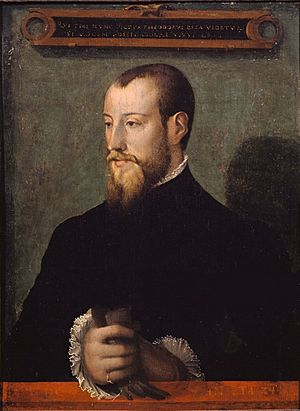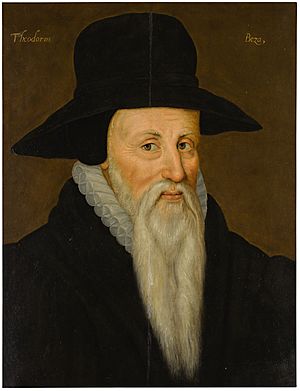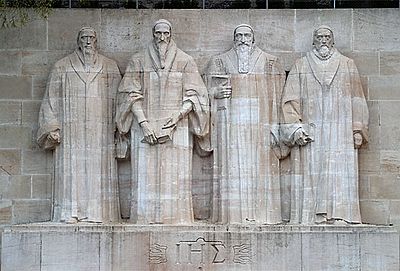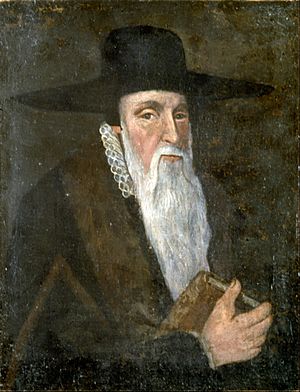Theodore Beza facts for kids
Quick facts for kids
Theodore Beza
|
|
|---|---|
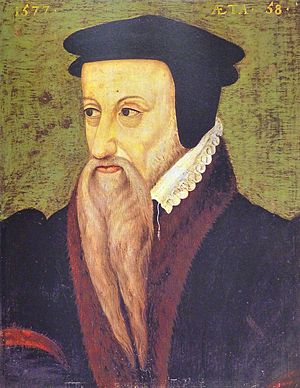
Portrait of Beza at age 58, 1577
|
|
| Born |
Théodore de Bèze or de Besze
24 June 1519 |
| Died | 13 October 1605 (aged 86) |
| Occupation | Theologian, author |
|
Notable work
|
Right of Magistrates (1574) |
| Theological work | |
| Era | Reformation |
| Tradition or movement | Calvinism |
| Main interests | Systematic theology |
| Notable ideas | Supralapsarianism |
| Signature | |
Theodore Beza (born June 24, 1519 – died October 13, 1605) was an important French Protestant leader during the Protestant Reformation. He was a theologian and scholar who followed the teachings of John Calvin. Beza lived most of his life in Geneva, Switzerland, and took over as the main spiritual leader of the city after Calvin passed away.
Theodore Beza's Story
His Early Life and Education
Theodore Beza was born in Vézelay, a town in Burgundy, France. His father, Pierre de Beze, was a royal governor, and his family was well-known. When Theodore was young, his uncle Nicholas, who was a member of Parliament in Paris, took him to Paris for his education.
In December 1528, Theodore went to Orléans to study with a famous German teacher named Melchior Wolmar. This was a very important time for him. Later, Beza followed Wolmar to Bourges, a city that was a center for the Reformation movement in France.
After Wolmar returned to Germany, Beza studied law in Orléans for four years (1535–1539). However, he found law boring and preferred reading classic Latin poems by writers like Ovid.
In 1539, he finished his law studies and moved to Paris. His family helped him get jobs that provided a good income. In Paris, Beza became well-known in literary groups. To avoid temptations, he secretly got engaged in 1544 to a young woman named Claudine Denoese. He promised to marry her publicly when he could.
In 1548, Beza published a collection of Latin poems called Juvenilia. This book made him famous as one of the best Latin poets of his time. Soon after, he became very ill. This illness made him think deeply about his life and faith. He decided to change his life and moved to Geneva, a city that welcomed Protestants. He arrived there with Claudine on October 23, 1548.
Becoming a Teacher in Lausanne
When Beza arrived in Geneva, John Calvin welcomed him. Beza then publicly married Claudine. Since he didn't have a job right away, he visited his old teacher Wolmar. On his way back, he met Pierre Viret in Lausanne, who helped him get a job as a professor of Greek at the academy there in November 1549.
While teaching, Beza wrote a play called Abraham Sacrifiant. This play compared Catholicism with Protestantism and was very popular. He also helped John Calvin finish translating the Psalms into French for the Genevan Psalter.
Beza also got involved in important discussions. He defended Calvin in a debate about predestination. He also wrote a book in 1554 defending the decision to punish Michael Servetus in Geneva.
Helping Protestants on Journeys
In 1557, Beza became very interested in helping the Waldensians in Piedmont, Italy, who were being treated badly by the French government. He traveled with William Farel to several cities like Bern, Zürich, and Basel to speak on their behalf. They explained the Waldensians' beliefs, and their message was well-received by some Lutheran leaders.
In 1558, Beza went on another trip with Farel to Worms. They hoped to convince German Protestant leaders to help the persecuted Protestants in Paris. Beza even suggested uniting all Protestant Christians, but this idea was not accepted by everyone.
False reports made it seem like the attacks on Protestants in France had stopped, so no help was sent. Beza then went on another journey to convince leaders to send help to Paris.
Settling in Geneva for Good
When Beza returned to Lausanne, he faced some problems because of disagreements about church rules. He decided it was best to move to Geneva in 1558. There, he became a professor of Greek at the new academy. After Calvin's death, he also became a professor of theology. He also started preaching.
He finished updating a French translation of the New Testament. In 1559, he traveled to Heidelberg to help the Huguenots (French Protestants). He also defended Calvin's ideas against other theologians.
Beza also wrote down his own beliefs, which were published in Latin in 1560. This book was translated into several languages, including English, and helped spread Protestant ideas.
Important Events (1560–1563)
Things looked promising for Protestants in France. King Antoine of Navarre invited Beza to discuss the Evangelical faith, but Beza couldn't convince the king to fully support it.
In 1561, Beza represented Protestants at a meeting called the Colloquy of Poissy. He spoke very well, defending Protestant beliefs. The meeting didn't solve much, but Beza became known as a leader for all Reformed churches in France.
Another meeting was held in 1562, which granted some rights to Protestants. However, this meeting ended when it became clear that Catholics were preparing to fight Protestants. After a terrible event called the Massacre of Vassy, Beza quickly wrote letters to all Reformed churches. He joined the Huguenot leader Conde and his troops in Orléans.
Beza traveled to different cities to gather soldiers and money for the Protestant cause. He also wrote a statement explaining why the Protestant cause was right. He visited England, Germany, and Switzerland, but his efforts to get help were not always successful. He returned to Geneva in September 1563.
Taking Over from Calvin
Beza had been away from Geneva for almost two years. John Calvin was sick and couldn't work, so Beza needed to return to help lead the church and school. Calvin and Beza planned to share their duties, but Calvin died soon after, on May 27, 1564. Beza naturally became his successor.
Until 1580, Beza was the leader of the Company of Pastors and the main person guiding the important learning institution in Geneva that Calvin had started. He cared deeply about education. For nearly 40 years, young Protestant students came to his lectures to learn about Calvinist theology.
Beza was also a trusted advisor to city leaders and pastors. He helped start a law school in Geneva, where some of the best legal experts of the time taught.
Later Years and Challenges
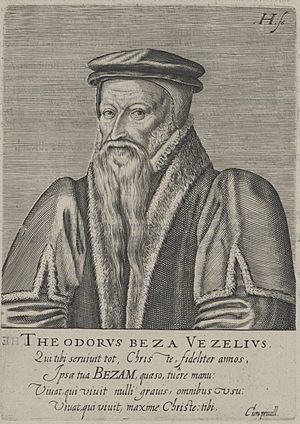
As Calvin's successor, Beza did a great job continuing Calvin's work and bringing peace to the Church in Geneva. The city leaders followed Calvin's ideas, and the church's spiritual matters were well-organized. There were no major disagreements about beliefs after 1564. Discussions were mostly about practical things, like how much power city leaders had over pastors.
Beza didn't force his ideas on others and tried to be a mediator when colleagues disagreed. He often defended the church's rights, but he also believed in working with the city leaders. Beza thought it was better for the Company of Pastors not to have a permanent leader. He convinced them to ask the city council for leaders to serve for limited terms. In 1580, the council agreed to a weekly rotating presidency.
He was very busy, helping with church and city matters, and writing to Protestant leaders across Europe. After the terrible St. Bartholomew's Day Massacre in 1572, he helped refugees find safety in Geneva.
In 1574, he wrote a book called De jure magistratuum (Right of Magistrates). In this book, he strongly spoke out against unfair rulers in religious matters. He said that people have the right to oppose bad leaders and even remove them if necessary.
Beza was not a great theologian like Calvin, but he was a talented writer, speaker, and leader in religious and political issues. He guided Calvinists all over Europe. Sometimes, in arguments, Beza could be a bit impatient or intolerant.
He stayed very close to the Reformed Church in France. He led a big meeting in 1571 at La Rochelle, where they decided to keep church rules strong and confirmed Calvinist beliefs about communion. He also took part in another important meeting in 1572 in Nîmes. He was also interested in the debates about the Augsburg Confession in Germany and wrote several works against those who disagreed with his views.
The Montbéliard Meeting
Beza's last major debate with Lutherans happened at a meeting in Montbéliard from March 14–27, 1586. He was invited by a Lutheran Count, but the goal of uniting the churches was not achieved. However, this meeting led to important discussions within the Reformed Church.
At this meeting, Beza explained his beliefs about predestination. This caused some disagreement, and a debate was arranged in Bern in 1588. Beza successfully defended his teachings, and they were declared correct.
His Final Days
After this, Beza focused more on his work at home. His wife, Claudine, died in 1588 after 40 years of marriage. On his friends' advice, he married a second time to Catharina del Piano, a widow from Genoa, to have someone to help him in his old age. He was healthy until he was about 65, but then his health slowly declined. He continued teaching until January 1597.
One of the saddest things for him in his old age was when King Henry IV converted to Catholicism in 1593, even after Beza's strong pleas. In 1596, a false rumor spread that Beza and the Church in Geneva had returned to the Catholic Church. Beza wrote a sharp response, showing he still had his strong spirit.
He died in Geneva. Unlike Calvin, he was not buried in the main cemetery. Instead, the city leaders had him buried in the monastery of St. Pierre to protect his body from those who might try to steal it.
Beza's Writings
His Humanist and Historical Works
Beza's writings can be divided into two main periods: his early humanist period and his later church-focused period. He wrote the first drama in French, Abraham Sacrifiant, which is still performed sometimes today. He also wrote satirical works like Passavantius. In his later years, he revised his poems.
His historical works include Histoire ecclesiastique des Eglises reformes au Royaume de France (1580), which tells the story of the Reformed churches in France. He also wrote a biography of Calvin and edited Calvin's letters.
His Theological Writings
Beza's theological writings are very important. In these, he showed himself to be a true follower of Calvin. He believed that everything that happens is part of God's plan. He explained his religious views in detail, especially in his work Summa totius Christianismi.
Beza also wrote De vera excommunicatione et Christiano presbyterio (1590), which strongly defended the right of church leaders (not civil leaders) to remove someone from the church.
Beza's Greek New Testament
Beza also made significant contributions to studying the Bible. In 1565, he published an edition of the Greek New Testament. It had the Latin Vulgate text and his own translation side-by-side. He also added many notes.
For his second edition in 1582, Beza may have used two very valuable old manuscripts: the Codex Bezae (which he later gave to the University of Cambridge) and the Codex Claromontanus (which he found in Clermont).
However, Beza mainly built on the earlier work of Robert Estienne (1550), which itself was based on editions by Erasmus. Beza's work was very helpful for future scholars. His Latin translation of the New Testament was published over a hundred times.
Even though some people think Beza's strong beliefs about predestination influenced his interpretation of the Bible too much, there's no doubt that he greatly helped people understand the New Testament better.
In Fiction
Theodore Beza appears as a character in the novel Colloqui di Poissy by Agostino di Bondeno (Rome, 2018).
See also
 In Spanish: Teodoro de Beza para niños
In Spanish: Teodoro de Beza para niños
- Franciscus Junius (the elder)
- Immanuel Tremellius
- Monarchomachs
- Supralapsarianism


